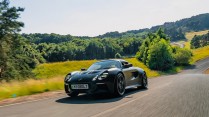New kings of the road: Big motorbike makers rev up in Southeast Asia
Oct 06, 2014 12:07 PM EDT

(Photo : REUTERS/DARREN WHITESIDE)
Roads in Southeast Asia have been getting a little louder lately as motorcycle makers, an aspiring middle class and easy bank credit come together to breed a new genus of motorcyclists - the big-bike rider.
Traffic in urban centers such as Jakarta, Kuala Lumpur and Ho Chi Minh City has long been characterized by swarms of small motorbikes and scooters. Honda Motor (7267.T) and Yamaha Motor (7272.T), the world's biggest motorbike makers, have dominated this sprawling regional market.
The landscape is slowly shifting as the Southeast Asian market, the world's third-largest after China and India, undergoes a structural change. In Malaysia and Vietnam, motorbikes with bigger engine capacities are outselling their smaller cousins.
Italy's Ducati Motor Holding [DUMTG.UL], Japan's Kawasaki and Austria's KTM (KTMP.VI) are among motorbike makers looking to build a new axis of growth in this market of 600 million people as orders for larger bikes in first-world countries slow.
They are wooing not just small-bike owners graduating to larger models. They are also chasing riders who already own a four-door subcompact sedan but have no qualms about taking on an additional financial commitment.
Harley-Davidson (HOG.N) plans to roll out a new entry-level motorcycle, the Street 750, in Southeast Asia early next year. The 749cc model has been a hit in India, with sales accounting for 60 percent of the company's local revenue two months after its launch in February. The bike costs 410,000 rupees ($6,663).
"We are optimistic about the Southeast Asian premium leisure motorcycle market," Marc McAllister, vice president and managing director of Harley-Davidson Asia-Pacific, told Reuters. "The motorcycle is perfectly suited to the region's infrastructure and fast-growing urban cities filled with a younger generation of riders who want an accessible premium ride."
The demand for premium bikes is in step with rising gross national income (GNI) in Indonesia, Thailand, Malaysia, Vietnam and the Philippines - vast countries held together by miles and miles of high-speed motorways, urban roads and rural byways.
In Vietnam, GNI per capita is approaching the key $2,000 level, data from the World Bank shows. Crossing that threshold marks the first phase of a shift in a population's spending from subsistence to moderate consumption, U.S.-based private equity and investment consulting firm TorreyCove Capital Partners said in a report in 2013.
Indonesia and the Philippines both breached the $3,000 level in 2012, while in Malaysia and Thailand, GNI per capita stood at $10,400 and $5,370, respectively, last year, according to the World Bank data.
In Vietnam, sales of larger models are outpacing the broader market, according to Harley-Davidson and Ducati. In Malaysia, sales of bikes with capacities of 250cc and above surged 49 percent last year, while the overall market was almost flat, local industry association data shows.
In Indonesia, the region's largest motorcycle market, bikes with similarly bigger capacities comprised 13 percent of total sales in 2013, up from 11 percent in 2012.
"We also see that not only bigger and heavier bikes will have a better volume, but also cross-touring motorcycles like BMW (BMWG.DE) and Triumph will have a better opportunity here," said Tony Tardjo, head of consumer lending of Indonesia's Bank CIMB Niaga (BNGA.JK).
"This kind of motorcycle offers the ability for on and off-road, which is suitable for Indonesian road infrastructure," he said.
EXTRA COMMITMENTS
With a monthly salary of 4,000 ringgit ($1,229), Hor Chee Fung, 28, is one of the region's new middle class earners, working hard to pay off monthly commitments from phone bills to car loans. But that didn't stop him from taking another loan to buy a larger and more powerful motorcycle.
"I don't mind taking that extra commitment to join my fellow riding friends," said Hor, a Kuala Lumpur-based financial analyst with International Business Machines Corp (IBM.N).
Hor is moving from a moped to a 250cc sports motorbike - the Kawasaki Ninja 250R. He plans to eventually upgrade to a Harley-Davidson or Ducati entry-level model when he gets a pay rise and promotion.
An entry-level Ducati, such as the Monster 795 assembled in Thailand, costs 59,900 ringgit in Malaysia, 18 percent cheaper than an entry-level Toyota Vios car. A Kawasaki Ninja 250R costs less, at 22,590 ringgit.
"These superbikes are highly affordable from 60,000 ringgit to the dream machines costing 500,000 ringgit and above," said Khairul Kamarudin, business development director at Bank Islam Malaysia Bhd, a unit of BIMB Holdings Bhd (BIMB.KL).
"As there are presently not many financial institutions providing superbike financing, we view this under-served community as an exciting prospect," he said. "We are in this superbike financing for the long haul."
A consumer banking manager from a Kuala Lumpur-based bank was more cautious. He said the superbike market is still small compared with car financing, though he agreed it is growing.
"I would say a lot of it is impulse buying," he said, adding that interest rates are high, as much as 10 percent if the client chooses zero downpayment.
Market research firm Nielsen estimates that middle class earners in Southeast Asia, or those with disposal incomes of as much as $3,000 a month, will more than double to 400 million by 2020.
CLOSE TO YOU
To be closer to this new growth segment, KTM, Europe's second-largest motorcycle maker, last year opened its first assembly plant outside Austria in the northern Malaysian state of Kedah. That came two years after Ducati, a unit of Audi AG (NSUG.DE), set up a factory in Thailand.
"We notice in Southeast Asia a clear demand for bigger engine capacities. Even premium high-end models like our 1290 Super Duke R show potential. But clearly the main business is done with products between 200 and 400cc," Thomas Kuttruf, PR manager at KTM Sportmotorcycle GmbH, told Reuters.
Apart from being closer to their customers, it also makes more economic sense for manufacturers to produce in Southeast Asia.
A regional free trade pact has meant lower import tariffs in the single digits. Bikes and components imported from outside the Association of Southeast Asian Nations (ASEAN) are slapped with duties of up to 30 percent, making them more expensive.
"The choice of the factory in Thailand, the first for us outside of Italy, was an important step... We are able to deliver Ducati motorcycles throughout Asia taking advantage of the ASEAN duty agreement," Pierfrancesco Scalzo, general manager of sales and marketing at Ducati Asia, told Reuters.
For now, market leaders Honda and Yamaha remain unfazed by the entry of other motorbike makers.
Like Ducati, KTM and Kawasaki, a unit of Kawasaki Heavy Industries Ltd (7012.T), Honda is starting to offer bigger bikes, producing the CB500 and CB650 series in Thailand.
"We are not competing with the other manufacturers," Yuka Abe, a Tokyo-based Honda spokeswoman told Reuters. "But we do this because in Asia, demand for bigger models is increasing while in developed countries, the demand for the same is decreasing."
Yamaha is not about to be left behind. The world's second-largest motorcycle maker has recently started producing a new 250cc sports motorcycle in Indonesia - the R25 - and is looking to launch the model worldwide soon.
Copyright @ MOTORTIMES, All rights reserved. Do not reproduce without permission.








